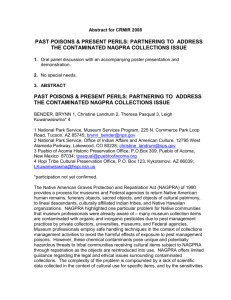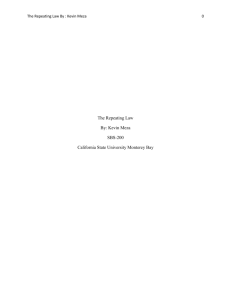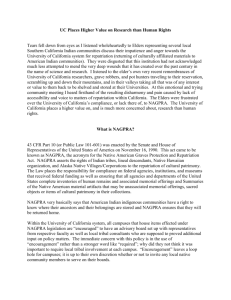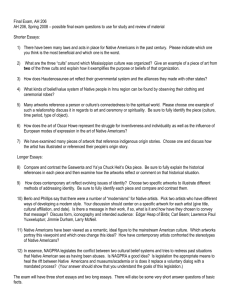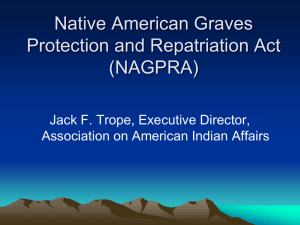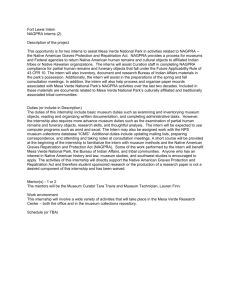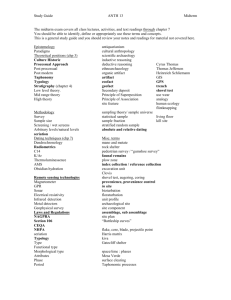CSU Meeting Summary
advertisement
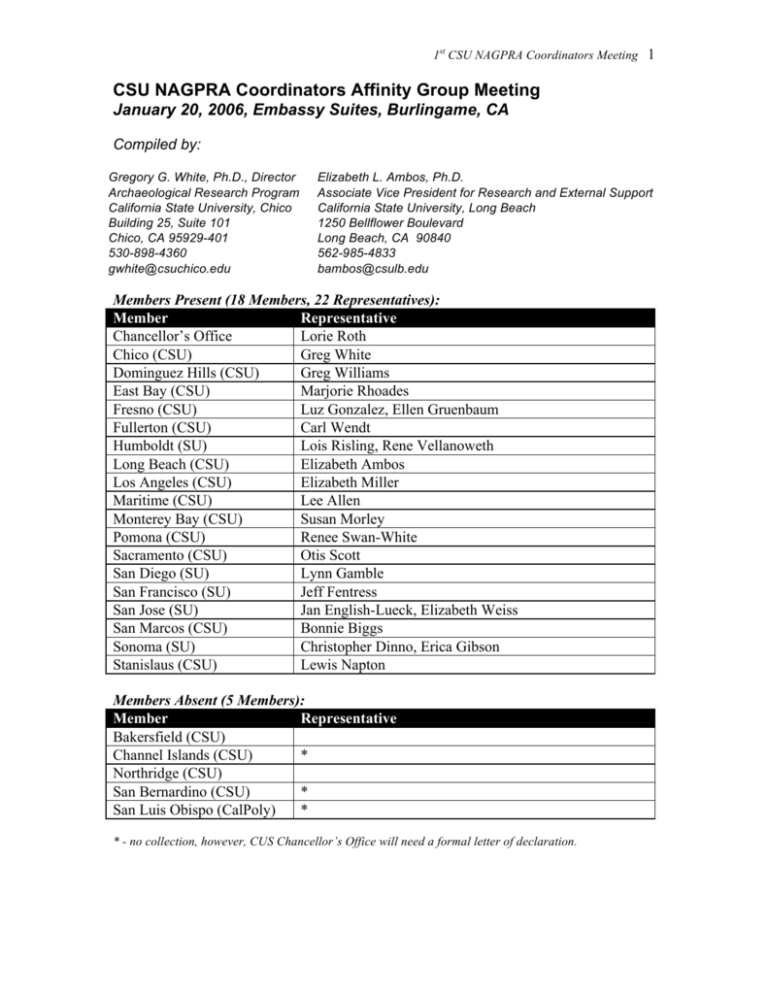
1st CSU NAGPRA Coordinators Meeting 1 CSU NAGPRA Coordinators Affinity Group Meeting January 20, 2006, Embassy Suites, Burlingame, CA Compiled by: Gregory G. White, Ph.D., Director Archaeological Research Program California State University, Chico Building 25, Suite 101 Chico, CA 95929-401 530-898-4360 gwhite@csuchico.edu Elizabeth L. Ambos, Ph.D. Associate Vice President for Research and External Support California State University, Long Beach 1250 Bellflower Boulevard Long Beach, CA 90840 562-985-4833 bambos@csulb.edu Members Present (18 Members, 22 Representatives): Member Representative Chancellor’s Office Lorie Roth Chico (CSU) Greg White Dominguez Hills (CSU) Greg Williams East Bay (CSU) Marjorie Rhoades Fresno (CSU) Luz Gonzalez, Ellen Gruenbaum Fullerton (CSU) Carl Wendt Humboldt (SU) Lois Risling, Rene Vellanoweth Long Beach (CSU) Elizabeth Ambos Los Angeles (CSU) Elizabeth Miller Maritime (CSU) Lee Allen Monterey Bay (CSU) Susan Morley Pomona (CSU) Renee Swan-White Sacramento (CSU) Otis Scott San Diego (SU) Lynn Gamble San Francisco (SU) Jeff Fentress San Jose (SU) Jan English-Lueck, Elizabeth Weiss San Marcos (CSU) Bonnie Biggs Sonoma (SU) Christopher Dinno, Erica Gibson Stanislaus (CSU) Lewis Napton Members Absent (5 Members): Member Representative Bakersfield (CSU) Channel Islands (CSU) * Northridge (CSU) San Bernardino (CSU) * San Luis Obispo (CalPoly) * * - no collection, however, CUS Chancellor’s Office will need a formal letter of declaration. 1st CSU NAGPRA Coordinators Meeting I. 8:00-8:45 a.m. 2 Welcome and Roundtable Introductions Roth: The Chancellor’s office periodically engages with campuses to consult and request reports. This meeting is the first attempt to link campus programs together for issues related to NAGPRA compliance. The Chancellor’s office seeks to distribute and collect information, and considers it especially important to distribute information on new Cal NAGPRA legislation which is likely to produce system-wide concerns. In March, Roth will host a meeting of Provosts and will report our results. All: Roundrobin introductions. See list, above. Representatives from 17 campuses and the Chancellor’s office. Representatives hold a variety of positions within the CSU, including facilities planners, administration, deans, chairs, faculty, and staff. Non-represented campuses include three that lack collections and therefore determined that attendance was unnecessary (Channel Islands, San Bernardino, San Luis Obispo) and two non-responsive (Bakersfield, Northridge). Fentress: Our primary goal: arrive at a “state of the system” for the CSU by sharing information, including status of compliance to 1990 Federal NAGPRA law, collections status, and preparation for compliance to 2001 Cal NAGPRA. By end of meeting we can identify shared problems (e.g., funding, consultation, facilities) and establish positive goals for the affinity group. II. 8:45-10:15 a.m. Federal NAGPRA Fentress: Please refer to the NAGPRA flowchart (NAGPRA Training Home, Summary and Inventory pdf at http://www.cr.nps.gov/nagpra/TRAINING/INDEX.htm). Federal NAGPRA mandates federally funded institutions compile inventories of Native American sacred objects, human remains, and funerary objects. The goal is to facilitate repatriation to federally-recognized Indian Tribes (see NAGPRA Online Consultation Database for a list of tribes and contact info: http://www.cast.uark.edu/other/nps/nacd/). History of law: primary factors driving the law: (1) long history of destruction and improper treatment of Indian sites in the U.S. Showed picture of Indian burial in museum case-once on display at college near SFO. Must remember this in consideration of NAGPRA compliance, (2) long history of laws to protect Indian sites and burial sites with increase in Native American involvement in site excavations. (3) Tribal activism. Laws on excavation practices did not extend into museums. In 86-87, concerted effort by Indian tribes to pass a comprehensive federal law. Smithsonian, SAA opposed the laws in the late 80’s. Turning point was when Smithsonian director stated that there were 18,500 human remains in their possession – led to passage of law in 1990. Reviewed basic law structure. Defined two different pathways within law. 1.”Summary” comprises sacred /culture patrimony objects (typically museum items) and tribal consultation. 2. “Inventory” includes human skeletal material 1st CSU NAGPRA Coordinators Meeting 3 and funerary objects; cultural affiliation research and consultation. Defined basic terms (minimum number of individuals represented by skeletal remains, associated/unassociated funerary objects, Federal Register Notice types). Federal deadlines for compliance: Summary due 1993, Inventories due 1995. Noted lag time in response. SFSU Summaries submitted 1997, Inventories submitted 1999 and 2001. SFSU’s NAGPRA process presented as real-world example. SFSU process is best seen as an evolution. SFSU collections originated over last 50 years from both campus projects and as a CRM repository. Administration and Anthropology thought NAGPRA process would end with all materials repatriated to tribes. NAGPRA program began in 1996 with Julie London; she finished Summary and started Inventory. Jeff Fentress started 1998 did all consultation and submitted all inventories. Fentress is the only NAGPRA staff person at SFSU with salary as only budget. Other monies have been raised through grants and contracts. All other NAGPRA labor is has come from students. NAGPRA is now infused into Anthropology curriculum in cultural, physical and archaeology programs. Reviewed steps within federal compliance law with SFSU examples. Began with identification and organization of NAGPRA-subject collections through document research and physical search. Noted several areas defined by law are not clear cut in practice, e.g., identification of grave goods or sacred objects. Discussed concept of “preponderance of evidence.” The burden of proof for “objects of cultural patrimony” is placed on tribal representatives – there must be a preponderance of evidence to show “objects of cultural patrimony” – objects owned not by individuals but by the tribe. Extensive discussion ensued, using case examples. Rhoades: (CSUEB) Hopi Kachina dolls were recognized, but have not been repatriated. Gamble: Do we need to really document all objects? White: No, you are not obliged to include objects in the NAGPRA inventories that don’t qualify under the definitions. Risling: I helped write these descriptions, so can give perspective that the evidence for what was cultural patrimony should come from the tribe, not from the museum or other institution. Baskets can be both utilitarian and sacred object at the same time. Museums/CSU’s should put all items on the list, and let tribes decide. Gamble: She and the institution are trying to “do the right thing” – the issue is more that if you declare an object, then it becomes tied to an institutional responsibility. Fentress: You should consult with lawyers – either individually, or with system lawyers. This largely comes to individual philosophy, campus by campus. SFSU erred on the side of full disclosure by stating objects are of “possible” sacred/funerary objects. White: Tribes review the objects after the inventory, we are confined by law to this order of affairs. You can refile based on consultation with the tribe. Must invite consultation – must seek it out. 1st CSU NAGPRA Coordinators Meeting 4 Fentress: Consultation is essential part of defining “grey areas” what are funerary objects and associated funerary objects. These tend to be poorly documented in field records, also, our knowledge (archaeologists discipline development) is under development through time. Therefore, we may be constantly reevaluating associations such as sacred objects, human remains, artifacts. Once basic inventory of NAGPRA-subject material is compiled, the next step is determining legal control vs. possession. CSU campuses are legally given the role of determining control. Ownership must be established before consultation. Gave several examples: SFSU excavated from a property before land became State Park-SFSU has control. SFSU excavated from land after State Parks bought a property, State Parks has legal control. The basic issue is that somebody has to take responsibility. White: Please be mindful that any collections from Federal land must be curated according to the provisions of the Guidelines for Curation of Federally-Owned and Administered Archaeological Collections (36cfr79; see http://www.cr.nps.gov/archeology/TOOLS/36CFR79.HTM for the code and http://www.cr.nps.gov/archeology/collections/index.htm for the fed short course). If collections in your facility originate from Federal land, the Federal agencies retain ownership and your facility is a mere steward. This makes the agency an important consulting partner and potential funding source in association with NAGPRA and curation issues. Fentress: Nightmare scenario: SFSU had contract and collections from Bureau of Reclamation. There were many missing funerary objects and bodies. A collections building in Tiburon was destroyed by a mudslide; most of the collection had been moved several times. Consultation was initiated with many tribes; joint consultation was conducted with Bureau archaeologist and federal tribe; tribe made a claim. Almost got through the publication of the Federal Register notice. Then Bureau stopped repatriation claiming it had to determine who0 owned all the sites when they were dug in the 1960s. The Solicitor General’s office in D.C. must make the “ownership” decision. Eventually case wound up with Larry Myers to adjudicate. Determination of ownership of the collections is sometimes very tricky. The next step is to determine cultural affiliation. In the case of archaeological materials, the idea is to make a link between an archaeological culture and a modern day Indian tribe. This is the Kennewick Man type of cultural affiliation decision. Archaeologists can make a general determination – but this is also a “gray area.” Preponderance of evidence: physical, language, ethnographic is necessary. Tribal consultation is another form of evidence. Individual NAGPRA programs vary on defining cultural affiliation and use of tribal evidence. SFSU made a polcy of contacting both federally recognized and non-federally recognized groups. SFSU felt this was in the spirit of the law, but not required by the law. Many Bay Area Native Americans are not federally recognized but are recognized by the state. Bear in mind that “culturally unidentifiable” can mean materials are affiliated with a non-federally recognized group: example – Ohlone people – not yet federally recognized. 1st CSU NAGPRA Coordinators Meeting 5 Ultimately, you will have two choices: repatriation or curation. SFSU has over 900 individuals, 12,000 objects in our control and stored for federal and state agencies. We have published all our Notices for repatriation or they are in tribal review. We are in compliance with Federal NAGPRA. However, to date we have only repatriated 9 human remains, 650 objects. There are several reasons; some tribes have no land; some have not responded. All the tribes have not completed the repatriation – that’s really the issue – and explains why materials have not left the campus. The evolution of our process at SFSU has been very political. Administration was upset when all the materials were not repatriated and situation was not permanently resolved. NAGPRA is a hot political topic for American Indians studies, they are very concerned, as well as anthropology students and faculty. Break: 10:15 to 10:45 a.m. Dinno: Need to have high level guidance from a legal standpoint from the CSU, apply to all the CSU campuses. White: Yes, I’d encourage building an administrative context, that is make sure your campus is fully aware of the NAGPRA process and your administration is aware and takes into account all its consultation needs with tribal entities. Fentress: Must also be careful of OSHA/health and safety issues. Federal NAGPRA law requires disclosure of possible contaminants to tribes– many artifacts are contaminated with mercury and arsenic – result of past museum practices (see http://bss.sfsu.edu/calstudies/arttest/). SFSU tested facilities and found mercury everywhere. Labs were cleaned by SFSU. Tribal visitors are informed of status and safety procedures. White and I attended Cal NAGPRA commission meeting last summer (2005), Cal NAGPRA law does not include contamination clause; I brought up the issue with commissioners. Scott: Need to have the risk/harm to the university taken into consideration, but also need consultation with tribes –this has not often been done. Are there penalties for non-compliance? Fentress: remember that federal guidelines do state the government can “can assess civil penalties” – there can be harm to the campus through levy of fines. However, many many institutions have not met federal deadlines. Risling: if you are making an attempt to comply with the law – there will probably be no fines levied – if you are deliberately flaunting the law, probably there will be some negative outcomes, such as fines IV. 10:45 a.m. -11:30 p.m. Cal NAGPRA White: CalNAGPRA; Cal HSC Sections 8010-8030; Passed 2001; Signed law January 1, 2002; Not yet funded. Committee provisionally and intermittently active. Focused 1st CSU NAGPRA Coordinators Meeting 6 on state agencies and state-funded museums. All CSU’s come under this law. CalTrans and CSU’s are of high interest to individuals involved in Cal NAGPRA. Cal NAGPRA committee does not really have funding – committee members are meeting “on their own dime.” Cal NAGPRA Intent: Provides state policy to ensure that California Indian human remains and cultural items be treated with dignity and respect. Apply policy consistent with Fed NAGPRA. Facilitates implementation of Fed NAGPRA by publicly funded agencies and museums in California. Encourage voluntary disclosure and return of remains and cultural items by an agency or museum. Provides assistance to CA Indian tribes seeking a timely response and dispute resolution Cal NAGPRA Law: Creates the ROC repatriation oversight committee. ROC will develop and issue a list of Cal Indian tribes. Creates dispute resolution protocols, requires revised inventories, requires determination of affiliation, sets rapid pace for consultation and repatriation, establishes new penalties. ROC – Steve Banegas, Kesner Flores, Paul Cuero, Sonny Hendricks, Dorothy Mathews, Walt Lara, Leroy Elliot, R. L. Bettinger, Jennifer Gary. See Section 8013 for details of what must be done. Any new materials received will also need to be described and reported. Inventories and summaries due to the ROC by January 1, 2003, or within one year of the date on which the commission issues the list. The agency must list items excluded from Fed NAGPRA. Determination of cultural affiliation shall not be construed to authorize the completion or initiation of any scientific study of human remains or cultural items; submit inventory and summary to the ROC within 90 days of completion (note – this will be difficult to comply with in practice – probably study means destructive study). The ROC will publish notices of completion of summaries and inventories on its web site for 30 days, and make the inventory and summary available to any requesting tribe or state affiliated tribe on the ROC list. All Federally-recognized groups will be included, any indigenous California group on the BIA Branch of Acknowledge and Research petitioner list, or other groups that make a strong case. All CSU’s receiving a repatriation request must repatriate if – requested items meet definitions; cultural affiliation is established, campus can’t present a preponderance of countervailing evidence. Dispute resolution: everything will be frozen until resolution occurs, CSU campuses can file an objection. Penalties of $20K per each violation can be assessed. Thus, CSU’s should really make an effort to comply. ROC will likely support tribal claims, even if CSU’s file counterclaims. UC policy is that campus recommendations go forward to a system-wide board. This is quite a bit different from the CSU practice, which has involved campus by campus determinations. Each campus should expect: (1) Cal NAGPRA ROC may request CSU inventories; requires parallel documentation; duplication of all records and verification of Fed NAGPRA compliance; identify new consulting parties (non 1st CSU NAGPRA Coordinators Meeting 7 federal tribes); resolve conflicts between consulting parties; expedite repatriation claims; expedite claims for “unaffiliated remains.” There will be a need to develop standard materials release letter – have available to all CSU NAGPRA committees. Lorie Roth will likely be the representative from the CSU Chancellor’s office receiving a communication to comply with Cal NAGPRA. Compliance will require lots of campus resources. Note that the Chancellor’s office has deferred responsibility for compliance to each individual campus. However, the NAGPRA affinity group could develop an archive of best practices – forum, share documents, don’t have to re-create the wheel. We will form a network. Needs assessment of the group is key. White recently had a conversation with Sherry Hutt, Program Manager for Federal NAGPRA (see http://www.cr.nps.gov/nagpra/ and http://www.cr.nps.gov/nagpra/CONTACTS/INDEX.HTM for a list of National NAGPRA personnel). White asked Hutt for her perspective on the interface between State and Federal law. Hutt indicated that Cal NAGPRA was not developed in consultation with Federal NAGPRA, so the relationship will have to be developed in practice. In her opinion, owing to CSU’s use of Federal grants and permits that Federal NAGPRA will apply. Thus, Federal NAGPRA will generally ”trump” Cal NAGPRA. However, more to the point Federal NAGPRA will have jurisdiction over federally-recognized claims while internal regulations or a rewrite of NAGPRA Section 1010 will defer disposition of unaffiliated remains to the State process. Thus, CSU campuses should expect to follow theNAGPRA process for affiliated remains and the Cal NAGPRA process for unaffiliated remains. V. 11:30 a.m. - 12:00 p.m. Chancellor’s Policy and Expectations Roth: Chancellor’s Code Memo 90-14 (see Attachment D) is still the active policy. The original language (Chancellor Lewis McCune) delegated responsibilities to NAGPRA. Under the terms of this policy the Chancellor’s office will periodically check in with the campuses to determine status of NAGPRA/Cal NAGPRA compliance. I have prepared a summary of the NAGPRA status of each campus (see Attachment E). The Chancellor’s office now possesses a set of digital image files containing 2001 NAGPRA inventories from each campus. Roth will send CD’s of the 2001 updates to all NAGPRA coordinators. VI. 12:00 - 1:10 p.m. Free Lunch VII. 1:00 - 2:15 p.m. Campus-by-Campus Reports Roth: meeting reconvened. Progress on each campus. SJSU: (English-Lueck) Physical anthropologist and archaeologist recently retired: before that time, asked for all list of artifacts. We are in negotiation with a non-federally 1st CSU NAGPRA Coordinators Meeting 8 recognized tribe (Ohlone). We cannot repatriate until that tribe’s status is adjudicated. Cal NAGPRA may bring these issues back into focus. We have received some limited grant support, and are working on creating a database of all artifacts. Have a climate-controlled, secure/alarmed facility. (Weiss) We also need to do osteological studies in advance of repatriation. San Marcos: (Biggs) We have no collections and no intention of collecting. We have one anthropologist but are looking forward to instituting a major in 2007. Have been working with Native American library creation, making liaisons with local reservation and tribal communities. Humboldt State: We are in relative compliance. No skeletal remains or artifacts. We do have baskets, a boat, that may need to be repatriated. San Nicolas island collections (non-skeletal) may need to be catalogued. San Diego. (Gamble) We have large collections. KCRC (Kumeyay Cultural Repatriation Committee) is working with San Diego. Have experienced real anger against archaeologists. Received National Park Service NAGPRA grant, in partnership with the tribe. Collections were not in good shape, needed quite a bit of cataloguing work. Report is almost ready for publication – still under review. Have gone out in the field with members of Cal NAGPRA ROC, and have built relationships. Have seen some real difficulties with analyzing cremated remains – some are animal, some are human. Also had to move collections, thus creating quite a bit of storage and curation work. We also have the San Diego Presidio collection (1769): burials were excavated: some were Native, most were not. This has been a confusing repatriation process. Don’t see any immediate closure in the NAGPRA process at San Diego. CSUDH: (Williams) Small collection, don’t have details. CSULA: (Miller) We have three collection – (1) Guamanian, (2) San Nicolas Island – federal repository, (3) California archaeology. Our archaeologist, Patt Martz (CA archaeologist) has retired – don’t know details of her investigations. In addition, they have some forensic/coroner related human skeletal remains – some of which are Native American. We have also worked on repatriating some remains to tribes in Nevada – had the experience that although one round of consultation yielded no requests for repatriation, we have now initiated another round of requests for repatriation as seven new tribes have been identified as Federally-recognized since our original consultation. CSU East Bay: (Rhoades) CSU East Bay had an active archaeological program in the 1960s-1970s (George Miller, C.E. Smith). The anthropology museum contains collections from archaeological digs on Bay Area prehistoric sites; we also have large ethnographic collections (Lowell Bean). Completed inventories and summaries in late 90’s to come into compliance. However, the archaeological collections have long been separate from the anthropology museum so little coordination. We will be working on consultation with tribes to review the collection. Much of collection is currently listed as “culturally unidentified” CSU Monterey Bay: (Morley) We have a very small collection – mostly from Monterey Bay Community College – excavated in the 60’s. Also have some archaeological 1st CSU NAGPRA Coordinators Meeting 9 material from Carmel Mission. Mostly interested in the mediation between stakeholder groups, particularly in the Monterey Peninsula. Interested in progress that can be made with implementation of SB 18. Also interested in labeling and cataloging artifacts – and we need training. CSU Stanislaus: (Napton) We have no collections. No archaeologist until 1970’s – never got into collecting of skeletal remains. We have about 4 skulls, but they don’t appear to be Native American. CSU Sacramento: (Scott) We have some major, but not daunting challenges, to bringing the campus into full compliance. We have had some response from our archaeologists concerning our collections. NAGPRA process needs to be institutionalized on our campus. Coming into compliance raises resource questions – it’s expensive. We have a considerable number of collections – over 1,000 boxes. We have not really gone through them. We need personnel to catalog, and space to store and sort the collections. We have discovered that this must be an institutional responsibility not assignable to one or two faculty. We plan to create a NAGPRA committee, and charge that committee with oversight. CSU Cal Maritime: (Allen) We have bones from shipwrecks buried under bay mud. Some of our new buildings may result in inadvertent excavation of burials. Therefore, that’s why we are interested in NAGPRA compliance issues. CSU Fresno: (Gonzalez, Gruenbaum) NAGPRA issues have been of concern on campus for more than a decade. There have been rifts between archaeologists and Native American faculty, for example. We have completed repatriation of both culturally identifiable and culturally unidentifiable materials to the Santa Rosa Rancheria (Yokut), by making an appeal directly to the federal NAGPRA Review Committee. Our areas tribal remains are handled by the Central Valley and Mountain Re-Interment Association, organized by a tribal person who is a USFS Forest Archaeologist (Lorie Planas). The repatriation process was conducted by the community members and the University – President attended and said some words of “regret” about the treatment of the remains. Even though that process went well, we still have other parts of our inventory that we need to work on in terms of repatriation. If we are doing excavations, who is supervising them in terms of curation and compliance with Cal NAGPRA? One gray area is if researchers are doing work under the aegis of the research foundation – they aren’t in compliance with NAGPRA. Governance structures are different between the university and Foundation. Sonoma State University: (Gibson, Dinno) We have a collections building – Anthropological Studies Center (ASC). We have an ASC curation endowment fund which now supports NAGPRA activity. Have personnel time to bill to NAGPRA. Facility is not temperature controlled, but it is secure. Need to develop the second story. We have 60 different collections from 15 different counties. Our collections accumulated from the 1960s to early 90s. To our knowledge, we are compliant with Federal NAGPRA. Our inventories are complete, and draft notices have been filed. However, Cal NAGPRA will present new problems. One collection was reburied, one was repatriated. We have over 580 individuals, 2,500 associated funerary objects. Huge task. 1st CSU NAGPRA Coordinators Meeting 10 CSU Long Beach: (Ambos) archaeo-geophysicist who is assigned this responsibility (Dan Larsen) unavailable and I am filling in. We have some collections and NAGPRA/Cal NAGPRA concerns. We have filed inventories and are in compliance. CSU Fullerton: (Wendt) We have had quite a bit of staff/faculty turnover, thus haven’t made the progress we would have liked. We have full-time staff person who is working on cataloging the collections. Nothing was reported in the 1990’s – didn’t believe that the materials were reported correctly. We have about 7 skeletons – listed as “culturally unaffiliated” – need to work on this, obviously, for compliance with Cal NAGPRA. CSU Pomona(Swan-White): We don’t appear to have any collections, perhaps some bowls. Am working with oral histories of older tribal people. CSU Chico (White): Have extensive collections – also, campus partially on pre-1958 rancheria lands and contains prehistoric and historic resources. Thus, our campus has consultation concerns on a number of levels. We are also dedicated to training students for cultural resource management positions. We dig with tribal monitors on site, often work on burials at the request of tribes, including analysis and identification of remains. Have created fund to support the collection through accepting items for curation. Will need more space for collections, soon. Have written grants for consultation with tribal partners (see http://www.cr.nps.gov/nagpra/GRANTS/INDEX.HTM for grant instructions). We are visited about 20 times each year by tribal representatives. The President and Provost are ultimately responsible and I make sure to keep them advised. Break: 2:40 to 2:50 p.m. VIII. 2:50 - 3:20 p.m. Consultation Models White: Each campus needs to build an administrative context for Native American consultation. Consultation is a key part of the repatriation and curatorial process. Under Chancellor’s Code Memo 90-14, the President and Provost are tasked with NAGPRA and Native American consultation responsibilities. Each campus faces a variety of consultation imperatives: (1) diversity imperatives, (2) history and heritage themes for FMP/FMS, (3) the need for modern, tribally-informed curricula, (4) you may have existing collections, (5) you may have a CRM program or want to develop one, (6) the campus or lands managed by the administration or Foundation may include prehistoric or historical properties covered by heritage preservation law. Tribal members should also be participants in campus life, and diversity considerations for faculty, staff, and students are very important. Thus, there is an over-arching need to define consultation needs and practices, and each campus should evaluate these and incorporate NAGPRA/Cal NAGPRA consultation into the larger body of consultation protocols and objectives. At the same time, it is very important that your campus not seek to make NAGPRA/Cal 1st CSU NAGPRA Coordinators Meeting 11 NAGPRA consultation an instrument of its overall consultation strategy. NAGPRA/Cal NAGPRA has its own pace and is quite organic. It requires a measured, professional approach that abides by law and policy and the Chancellor’s requests. Here are my recommendations for a basic framework: 1. Establish a list of potential consulting parties. (i.e., who are the tribes in your coverage area? How do will you rank them in terms of your own priorities and interests? Who should you visit first? 2. Conduct the effort using a government-to-government model (i.e., direct your efforts to the tribal chairs and councils, invest your own executive personnel, ask to get on the tribal council meeting agenda and make a presentation to the full tribal council). 3. Regardless of the purpose of your meeting, it is likely that any meetings you might arrange will also become a forum for the full range of tribe-university relationships. This is a good thing, but it does mean that you will need to prepare your responses to other very important issues that might be raised (e.g., NAGPRA and human skeletal remains, access to scholarly resources, modern and meaningful curricula on CA Native Americans). 4. Find immediate and meaningful ways to engage tribes in university activity. For example: (a) host a California Indian student preview day, (b) ask each Department to identify classes that might benefit from visits and presentations by tribal scholars. Your diversity coordinator or another administrative entity on campus might then work to set up a “speakers invitation bureau” or list made up of tribal scholars willing to visit and present their perspectives on arts, Native American experience, or professional expertise in the form of a one-hour guest lecture. This would require a travel stipend, or (c) host a regional tribal fair emphasizing scholarly and professional pursuits. As for item 1 above, please make sure that your NAGPRA agenda does not become an instrument of your overall outreach effort. In other words, you may go to these meetings and hear from tribes that they’ll want nothing to do with you until NAGPRA issues are settled. You will be working on it, but by pain of law NAGPRA/Cal NAGPRA it has it’s own pace controlled by legal and financial preconditions. Prepare a response that allows you to express your respectful agreement and commitment to consultation and your hope that consultation might continue on a number of levels all at once. As for item 2, lists of Federally-recognized tribes are available at line Native American Consultation Database at http://www.cast.uark.edu/other/nps/nacd/. The California Native American Heritage Commission (http://ceres.ca.gov/nahc/) maintains a list of California Federally-recognized and non-Federally recognized tribes and can be consulted for names and addresses. However, Provosts, NAGPRA committees, or NAGPRA representatives on each campus, should take this responsibility seriously and approach it professionally. Learn about tribes, become familiar with tribal history, and research the history of each tribe’s interactions with your campus. 1st CSU NAGPRA Coordinators Meeting 12 In the CSU Chico example, we have identified a variety of consultation concerns. We recently signed a memorandum of understanding with our most immediate tribal neighbor, the Mechoopda Indian Tribe of Chico Rancheria. This document, called a “Guiding Principles” document, was developed based on the tribal consultation model advocated by the National Association of Native American Tribal Heritage Preservation Officers (NATHPO) Best Practices Guidleines (see http://www.nathpo.org/about.html). The CSUC-Mechoopda Guiding Principles document is comprehensive in terms of building a formal relationship, and represents an agreement to communicate and act respectfully on a government-togovernment basis. You will need financial resources to make all this happen and do what is necessary to get out of crisis management mode when relating to community partners such as tribal entities. Roth: the CSU now has new Trustees who are very interested in under-served constituencies, so this kind of outreach activity will be well-received. Ambos: need to focus on partnership development, active listening: many lessons learned from CSU work with school districts in partnership could perhaps be applied to building relationships with Native American groups. Also, try to have a “deep” enough team of people on each campus involved in these issues that you can have stability and continuity in relationships with community/tribal partners. Fentress: Yes, need a lot of consultation to resolve grey areas, deep relationship building, visits with tribal groups. The urban situation is very different. It is expensive and difficult for tribal people to travel to San Francisco. The difference with Cal NAGPRA is that there is no funding for tribal visits. Federal NAGPRA has consultation grants and consultation work on Federal and State collections are funded by agencies. Concerning consultation, we have an NAGPRA advisory board at SFSU with some AIS people. One AIS person this week said that at University of New Mexico, holding the collections is seen as a stewardship responsibility not as ownership. Collections are treated as tribal materials and are handled according to each tribes wishes. Since some groups may not repatriate for whatever reason, the access to the materials represents a form of repatriation. IX. 3:30 - 4:00 p.m. Summary, Discussion, Goals Miller: Would Chancellor’s office be willing to put up money to support some of these activities? I don’t see my campus able to put up these funds. Scott: I am also interested in resources provided by the Chancellor’s office. Would like to have Provosts take this up as a topic. Trustees and Chancellor are ultimately responsible. 1st CSU NAGPRA Coordinators Meeting 13 Roth: Under Chancellor’s Code Memo 90-14, each campus has responsibility for complying with the NGPRA/Cal NAGPRA. However, we have seen some movement, for example, the Chancellor’s office has funded this meeting. Ambos: Would like some CSU counsel time dedicated to analysis of NAGPRA and Cal NAGPRA. White: Based on a couple of experiences, the current counsel has little expertise on either cultural resource or repatriation law. Not likely to be of much help. The expertise really resides in this room and elsewhere on campus. Fentress: I had a request for a detailed Cal NAGPRA budget a few years ago, estimating compliance….what happened to that? Can we use this as a way to determine budgets for campuses? Extensive, somewhat heated discussion ensued. Luz mentioned that we are all engaged in this, and thus of good will, or else we would not be at this meeting. White recommended that we all approach the concerns professionally. Roth: Thank you to the entire group for a great and productive meeting. Meeting adjourned at 4:06 p.m. 1st CSU NAGPRA Coordinators Meeting 14 Attachment A: Action Items For the Chancellor’s Office: (1) Report the results of our meeting at the Provosts meeting. (2) Update the nagpra@calstate.edu list-serv. (3) Send copies of CD’s from previous federal NAGPRA updates to each campus. (4) Consider a web site with NAGPRA/Cal NAGPRA resources for campus coordinators. For each campus: (1) Engage the Provost, report the results of this meeting and make recommendations. (2) Conduct a NAGPRA/Cal NAGPRA status and needs assessment and report to your Provost. (3) Evaluate your consultation status and needs and develop a consultation plan based on a government-to-government model, and present to your Provost. (4) Evaluate collection ownership and determine if you have State or Federal partners. Engage these partners because they may be responsible for curation/reporting costs and/or consultation. For the organizers: (1) Use the listserv to distribute useful information, models, links. (2) Use the listserv to field requests for information and assistance. (3) Develop a final report of our meeting with recommendations and an Executive Summary that can be used by individual coordinators to engage the Provost and establish an administrative context. (4) Develop plans for future meetings and NAGPRA Coordinators actions. (5) Explore sources of financial and organizational support for meetings, actions, and campus needs. 1st CSU NAGPRA Coordinators Meeting 15 Attachment B: Executive Summary The Law NAGPRA: The Native American Graves Protection and Repatriation Act (NAGPRA) is a Federal law passed in 1990. NAGPRA establishes legal imperatives and a process for federally funded institutions, museums, and Federal agencies to make a detailed accounting of certain Native American cultural items -- human remains, funerary objects, sacred objects, and objects of cultural patrimony – and for the return of those items to lineal descendants, culturally affiliated Indian tribes, and Native Hawaiian organizations. The National NAGPRA program considers the CSU campuses to be responsible under this law. Cal NAGPRA: The California Native American Graves Protection and Repatriation Act (Cal NAGPRA) is a State law enacted on January 1, 2002. It is not yet funded but provisionally active. It is focused on State agencies and CSU facilities are high on its list of concerns. It provides state policy to ensure that California Indian human remains and cultural items be treated with dignity and respect, under a policy consistent with the Fed NAGPRA, but also accelerates the process and provides assistance to CA Indian tribes seeking a timely response and dispute resolution with CA state agencies and museums. Differences: (1) Fed NAGPRA covers culturally identifiable (federally recognized tribes) items and remains, while Cal NAGPRA covers both federally recognized and non federally recognized tribal materials; (2) different reporting requirements; (3) different schedules; (3) different review committee; (4) different dispute resolution procedures; (5) different penalties, and; (6) different tribal entities may be specified (Cal NAGPRA may provide a repatriation mechanism for non-federally recognized California tribes). The Policy The Chancellor’s Office has delegated responsibility for NAGPRA, CalNAGPRA, and Native American consultation matters to the individual campuses. Current CSU policy is codified in Code Memo, 90-14, dated November 16, 1990 (Acting Chancellor Ellis McCune): “The President of each CSU campus is delegated the responsibility for developing and implementing campus policy regarding collections of Native American skeletal remains and associated grave artifacts. The campus president is also delegated the authority and responsibility to negotiation of agreements with Native American communities and the California Native American Heritage Commission regarding repatriation of campus collections and Native American skeletal remains and associated grave artifacts.” The Chancellor’s Office has no plans to issue policies, procedures, or recommendations. The only time they will be involved with implementation of NAGPRA is when the 1st CSU NAGPRA Coordinators Meeting 16 legislature asks them to collect and submit campus materials. In this event, the Chancellor’s Office will transmit the request to the campuses and assemble the results. Native American Consultation Needs NAGPRA and Cal NAGPRA both require extensive consultation, including distribution of inventories, coordination of repatriation requests, and consultation on the identification of items of cultural patrimony. NAGPRA/CalNAGPRA compliance is also imbedded in larger campus-by-campus Native American consultation needs and interests. Each campus should establish an administrative context for NAGPRA and CalNAGPRA, and work with Native Americans on issues related to curation and repatriation in the larger context of academic goals, services, and partnerships. Cal NAGPRA Concerns The Cal NAGPRA Repatriation Oversight Committee (ROC) is deliberately weighted to tribal interests and the law focuses on expediting claims. Cal NAGPRA is relatively dormant right now, but as soon as it is funded the ROC will act to develop a list of consulting parties (tribes). When this is done, a series of obligations will arise. Cal NAGPRA ROC may send a request to the Chancellor’s Office for CSU inventories. This may require duplication of all records and verification of Fed NAGPRA compliance as well as new documentation for previously-determined unaffiliated remains. The ROC will expect each campus to engage with consulting parties (including non-fed tribes). The ROC will expect the campuses to expedite repatriation claims, and will act quickly to resolve conflicts between consulting parties. Recommendations We have recommended that each campus NAGPRA/Cal NAGPRA coordinator engage with their Provost and report the results of the Affinity Group meeting and make recommendations. We have recommended that each campus conduct a NAGPRA/Cal NAGPRA status and needs assessment and report to the Provost. We have recommended that each campus evaluate its consultation status and needs and develop a consultation plan based on a government-to-government model, and present it to the Provost. 1st CSU NAGPRA Coordinators Meeting Attachment C: Fed NAGPRA Flowchart 17 1st CSU NAGPRA Coordinators Meeting 18 Attachment D: Chancellor’s Code Memo 90-14 (1/2) 1st CSU NAGPRA Coordinators Meeting 19 1st CSU NAGPRA Coordinators Meeting Attachment E: Campus Compliance Summary 20
